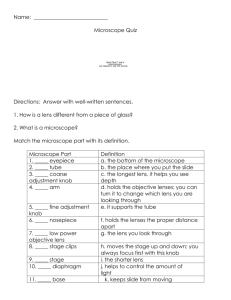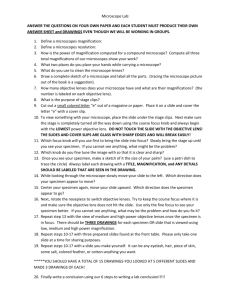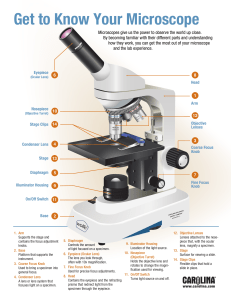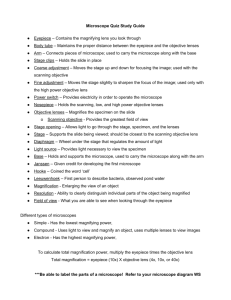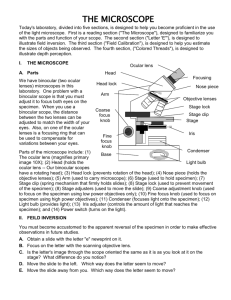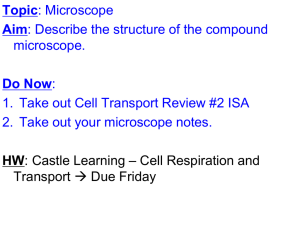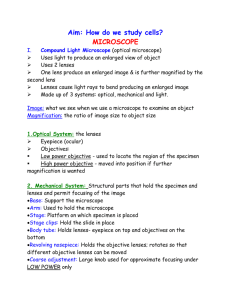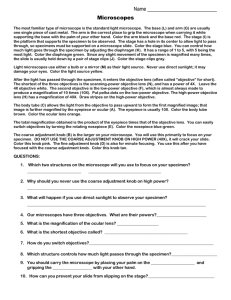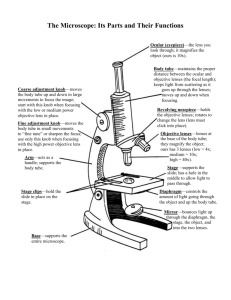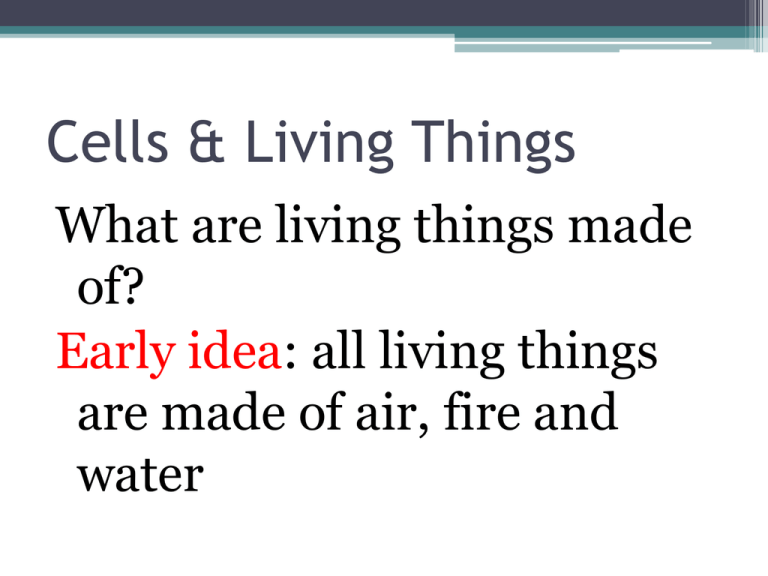
Cells & Living Things
What are living things made
of?
Early idea: all living things
are made of air, fire and
water
Now: all living things are
made of cells (cell theory)
Cell: the
basic,
functional
unit of life
Characteristics of Living Things
All living things...
1. Grow
2. Move
3. Respond to stimuli
4. Reproduce
Growth
•A result of the cells in your
body increasing in number
•New cells will grow to
replace old cells that die.
Movement
•A change in position, shape
or location (locomotion)
Respond to Stimuli
•Stimulus: anything that
causes an organism to react.
•Maybe external or internal
Identify the stimulus & response
Reproduction
•Producing more of the same
kind (offspring)
The Compound Light Microscope
The Compound Light Microscope
PART
FUNCTION
Eyepiece
Viewing lens....has 10x power
Body tube (barrel)
Connects ocular lens to objective lenses
Coarse adjustment knob
Rapidly moves stage up and down to focus image
Fine adjustment knob
Slightly moves stage to clearly focus image
Objective lenses
Magnify image various amounts (20x,30x,40x)
Revolving nosepiece
Rotates to change magnification by obj. lenses
Stage
Holds specimen slide...moves to focus image
Iris diaphragm
Controls amount of light passing through
specimen
Light source
Illuminates specimen
Base
Bottom of scope...contains light source
Arm
Connection between viewing lenses and
specimen...used to properly carry scope
Total Magnification...
power of objective lens
power of eyepiece lens
Core Lab Activity 10-1A
Setting Up and
Using a Microscope
Pg.384-5
The Cell Theory states:
•The cell is the basic unit of
life.
•All living things are made of
one or more cells.
•All cells come from other
living cells.
Cell Organelles...
Cell membrane:
•Found in both plant and animal
cells
•Surrounds and protects the
contents of the cell
•Controls the movement of
materials in and out of the cell
Cytoplasm:
•Found in both plant and
animal cells
•Jell-like fluid that in which the
organelles float
•Helps to move materials like
food to different parts of the
cell
Cell wall:
•Found only in plant cells
•Tough, rigid structure that give
plant cells their box-like shape
•Made mostly of cellulose
Nucleus:
•Found in both plant and
animal cells
•Large round structure often
visible
•Contains the chromosomes
•The “control centre” of the cell
Vacuole:
•Balloon-like spaces in the
cytoplasm
•Store materials that can not be
used right away
•Found in both plant and
animal cells (smaller and more
numerous in animal cells)
Mitochondrion:
•Oval, bean-like structures
•Produces energy by breaking
down food particles
•Found in both plant and
animal cells
Chloroplast:
•Green structures that contain
chlorophyll
•Capture the sun’s energy for
photosynthesis
•Found only in plant cells
PLANT
ANIMAL
Cell membrane
Cytoplasm
Cell wall
Brick shape
Round shape
Nucleus
Vacuole
Mitochondrion
Chloroplast
Large & few
Small & many
Plant vs. Animal Cells
Vacuole
Dividing Cells
•Necessary for growth and
reproduction
•Will replace cells that are
dead or in need of repair
•How does this happen?
Mitosis
•Occurs in body cells
(somatic cells) not in sex
cells (egg and sperm cells)
•Bacteria cells reproduce in
this matter
Energy for Cells
•Cells need energy for all life
processes.
•Energy is stored in food
called glucose (a type of
sugar)
•To release energy cells must
carry out cellular
respiration. Here the
energy is converted to
another form of energy.
•Takes place in the
mitochondrion.
•Most energy is released as
heat.
•Oxygen is necessary for
cellular respiration.
•Carbon dioxide and water
vapour are waste gases
produced. These are
removed from the cell.


